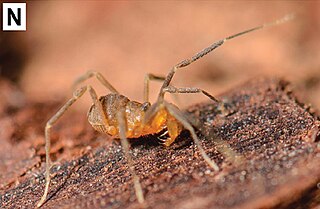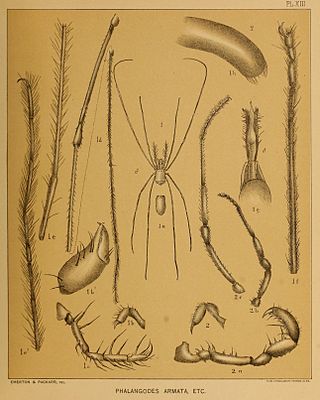
The Opiliones are an order of arachnids colloquially known as harvestmen, harvesters, harvest spiders, or daddy longlegs. As of April 2017, over 6,650 species of harvestmen have been discovered worldwide, although the total number of extant species may exceed 10,000. The order Opiliones includes five suborders: Cyphophthalmi, Eupnoi, Dyspnoi, Laniatores, and Tetrophthalmi, which were named in 2014.

Dyspnoi is a suborder of harvestmen, currently comprising 43 extant genera and 356 extant species, although more species are expected to be described in the future. The eight families are currently grouped into three superfamilies: the Acropsopilionoidea, Ischyropsalidioidea, and Troguloidea.

Texella is a genus of armoured harvestmen in the family Phalangodidae. There are more than 20 described species in Texella.

Zuma is a genus of harvestman in the family Paranonychidae. There are at least two described species in Zuma, found in central and northern California.

Vonones is a genus of armoured harvestmen in the family Cosmetidae. There are at least two described species in Vonones.
Enigmina is a genus of armoured harvestmen in the family Phalangodidae. There are at least two described species in Enigmina.

Isolachus is a genus of armoured harvestmen in the family Cladonychiidae. There is one described species in Isolachus, I. spinosus, found in Oregon and Washington.

Paranonychus is a genus of harvestman in the family Paranonychidae. There are at least three described species in Paranonychus.

Phalangodes is a genus of armoured harvestmen in the family Phalangodidae. There is at least one described species in Phalangodes, P. armata.
Arbasus is a genus of armoured harvestmen in the family Cladonychiidae. There is one described species in Arbasus, A. caecus. It is found in the Pyrenees of southern France.

Briggsus is a genus of armoured harvestmen in the family Cladonychiidae. There are about five described species in Briggsus, found in the coastal forests of Oregon and Washington.
Buemarinoa is a genus of armoured harvestmen in the family Cladonychiidae. There is one described species in Buemarinoa, B. patrizii, found in Sardinia, Italy.

Holoscotolemon is a genus of armoured harvestmen in the family Cladonychiidae. There are about eight described species in Holoscotolemon, found in Europe.
Izunonychus is a genus of harvestman in the family Paranonychidae. There is one described species in Izunonychus, I. ohruii, endemic to Japan.

Kainonychus is a genus of harvestman in the family Paranonychidae. There is one described species in Kainonychus, K. akamai, endemic to Japan.
Kaolinonychus is a genus of harvestman in the family Paranonychidae. There are about five described species in Kaolinonychus, endemic to South Korea and found primarily in caves.
Nippononychus is a genus of harvestman in the family Paranonychidae. There is one described species in Nippononychus, N. japonicus, endemic to Japan.
Travunia is a genus of harvestman in the family Travuniidae. There are four described species in Travunia. They are found in caves in the southern Dinaric Karst region of Balkan Europe.

Trojanella is a genus of harvestman in the family Travuniidae. There is one described species in Trojanella, T. serbica. It has been found only in a single cave on Stara Planina Mountain in Serbia.











